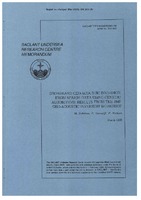| dc.contributor.author | Siderius, Martin | |
| dc.contributor.author | Gerstoft, Peter | |
| dc.contributor.author | Nielsen, Peter L. | |
| dc.date.accessioned | 2018-10-11T14:08:42Z | |
| dc.date.available | 2018-10-11T14:08:42Z | |
| dc.date.issued | 1998/03 | |
| dc.identifier | 11974 | |
| dc.identifier.govdoc | SM-343 | |
| dc.identifier.uri | http://hdl.handle.net/20.500.12489/503 | |
| dc.description.abstract | Matched field acoustic inversion techniques were investigated | |
| dc.description.abstract | using data from sparsely populated, vertical receiving arrays and a single receiver element. The purpose of considering sparse data sets is to investigate, by simulation, the feasibility of reducing the number and complexity of acoustic measurements needed for geo-acoustic inversion. The entire bandwidth of the 1997 G-Acoustic Inversion Workshop data (25-500 Hz) was used to compensates for the lack of spatial information when a limited number of receivers is considered. Forward model PROSIM and inversion code SAGA were applied to benchmark cases: sd, wa, and n. The inversion results generally showed good agreement with the ground truth, for full arrays, sparse arrays and single receiver elements. With a simple two layer model, an effective sound speed profile in the bottom was determined, which produced a good fit between model | |
| dc.description.abstract | and observed pressure fields for the multi-layer case n. | |
| dc.format | vi, 22 p. : ill. ; 7 fig. | |
| dc.language | English | |
| dc.publisher | NATO. SACLANTCEN | |
| dc.subject | Geoacoustic inversion | |
| dc.subject | Genetic algorithms | |
| dc.subject | Matched-field processing | |
| dc.title | Broadband geo-acoustic inversion from sparse data using genetic algorithms: results from the 1997 Geo-Acoustic Inversion Workshop | |
| dc.type | Scientific Memorandum (SM) | |
